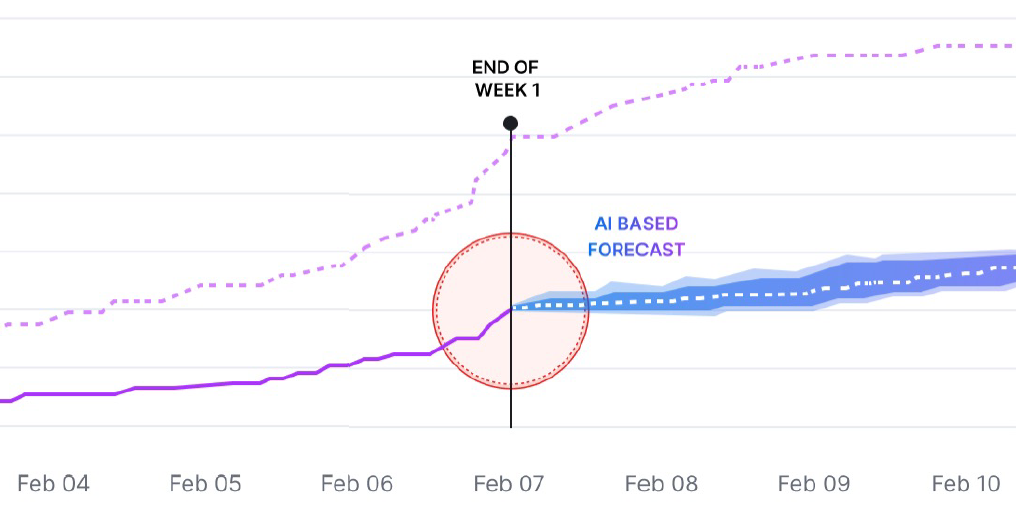CPG Analytics
AI-powered CPG analytics: the CINDE CPG Enterprise Suite
In today’s rapidly evolving consumer goods landscape, the CINDE CPG Enterprise Suite stands as a beacon of innovation. This unified, AI-driven set of applications transforms raw data into actionable insights across sales, merchandising, promotions, and assortment.

Boost performance with
CPG analytics
-
6-10%
incremental revenue uplift
-
25%
time saved each week
-
5-10%
boost in promotional ROI
CPG industry challenges
CINDE CPG Enterprise Suite meets these challenges head-on.
CINDE CPG Enterprise Suite: no more guesswork – just answers.
By anticipating market shifts, optimizing shopper engagement, and driving sustainable growth, you’re not just adapting to change – you’re leading it. Unified data, precision decision-making, and speed to action underpin every aspect of the CINDE CPG Enterprise Suite, ensuring sustainable, consumer-focused revenue growth management (RGM).
Learn about RGMBenefits of AI-powered CPG analytics
Optimize pricing and promotions
SymphonyAI can analyze millions of data points to recommend the perfect strategy for each product and channel, boosting promotional ROI.
Improve demand forecasting
SymphonyAI models can utilize vast data sets to enhance the forecast with amazing accuracy, reducing forecast error and helping you stay ahead of trends.
Boost trade promotion effectiveness
SymphonyAI can design, optimize, and automate promotional calendars tailored to each retailer, increasing trade spend efficiency.
Analytics capabilities of CINDE CPG Enterprise Suite
Get a unified view of your entire operation – from HQ to supply chain, all the way to the store, SymphonyAI can integrate disparate data sources to provide real-time insights across your business, driving revenue growth saving your team hours each week.
Trade Spend Allocation
CPG companies spend 11-15% of annual revenue on trade promotions, yet most lack the tools to optimize allocation. (Citation: POI State of the Industry, 2024). The CPG Enterprise Suite provides AI-powered insights to guide smarter trade spend decisions by region, channel, and promotional response. Invest where growth is happening while maintaining value in key accounts.
Trade Promotion Optimization
Most CPGs struggle to execute promotions effectively due to siloed data. Our AI-powered platform integrates internal and external data to deliver predictive scenarios, optimized trade fund allocation, and AI-driven promotional plans. The result: increased revenue and EBITDA growth through smarter trade promotion.
Bottom-Up Promotional Calendar
The CINDE CPG Enterprise Suite uses post-promotion analysis, promotion optimization, and AI to build a data-driven promotional calendar in minutes. It recommends the best timing, frequency, and pricing for maximum impact. By automating calendar creation, your team saves valuable time while ensuring your strategy is built on robust, predictive insights for greater market effectiveness.
AI-driven CPG analytics for leading companies
CINDE CPG Enterprise Suite
Real-time prescriptive insights that uncover opportunities and actions required to anticipate and respond to customer needs and accelerate growth.
Localized, customer-centric and space-aware assortment decisions at scale and speed to drive customer satisfaction, loyalty, and growth.
AI-powered promotion optimization to create customer-centric plans, reduce ineffective promotions, and drive better Retailer / CPG collaboration.
Real-time view into any store, any aisle, any category, using the most advanced AI and OCR technology to maximize revenue growth.
Connecting CPGs and retailer supply chains, providing the visibility and insights needed to drive better forecasting and decision-making.
The future of CPG analytics is powered by SymphonyAI
Learn how the CINDE CPG Enterprise Suite, an AI-driven platform, transforms raw data into actionable insights across sales, merchandising, promotions, and assortment.
CPG industry FAQs
The team at SymphonyAI is here to answer your questions about retail CPG solutions. Here are some of the most common.
The CINDE CPG Enterprise Suite empowers Revenue Growth Management (RGM) by leveraging AI to optimize pricing, promotions, and assortments. It uses advanced algorithms to analyze consumer demand, competitive pricing, and sales data, recommending strategies that maximize ROI and align with long-term brand objectives. CINDE enhances promotional effectiveness by automating calendars, analyzing incremental sales and ROI, and refining future strategies. The platform supports data-driven assortment decisions, identifying winning SKUs and tailoring product mixes by region and channel. Additionally, it provides AI-powered insights for trade investment management, optimizing budget allocation and improving trade spend efficiency. Its predictive AI capability, enabled by Copilot and now evolving into agentic AI use cases, allows the platform to not only anticipate market shifts but also respond dynamically with actionable recommendations, empowering CPG companies to optimize shopper engagement and drive sustainable growth.
CINDE achieves it’s capabilities by integrating data from a wide array of sources, including third-party subscriptions, syndicated data, market data, retailer sales and loyalty data, and internal BI datasets. By unifying disparate data streams in real-time, CINDE delivers a holistic view of the business, enabling cross-functional teams to make smarter, faster decisions. This combination of advanced analytics, real-time data integration, and AI-driven recommendations empowers CPG companies to optimize shopper engagement, drive sustainable growth, and maintain a competitive edge in dynamic markets.
Companies using the CINDE CPG Enterprise Suite can expect to see:
- 6-10% incremental revenue uplift
- 25% time saved each week
- 5-10% boost in promotional ROI
Consumer Packaged Goods (CPG) refers to products that are manufactured and sold to consumers, typically designed for frequent use and replacement. These include both non-durable goods, such as food, beverages, personal care items, and cleaning supplies, as well as certain durable goods, like small appliances, cookware, or batteries. CPG products are characterized by their packaging, ease of distribution, and wide availability across various retail channels, such as grocery stores, drugstores, and e-commerce platforms.
Within CPG, there is a subset called Fast-Moving Consumer Goods (FMCG), which focuses specifically on non-durable products with high turnover rates and low price points, such as snacks, soft drinks, and toiletries. While all FMCGs are CPGs, not all CPGs are FMCGs—for example, a toothbrush is a CPG but not an FMCG due to its slower turnover, whereas toothpaste is both a CPG and an FMCG. This distinction highlights that CPG encompasses a broader range of products, including durable items with slower sales cycles, whereas FMCG strictly targets fast-selling essentials.
An example of a Consumer Packaged Good (CPG) in the U.S. market includes a wide range of products from both non-durable goods and durable goods categories:
- Non-Durable Goods (FMCG subset): Products like Coca-Cola (beverages), Lay’s (snacks by PepsiCo), Tide (laundry detergent by Procter & Gamble), and Crest (toothpaste by Procter & Gamble). These are fast-moving consumer goods (FMCGs) purchased frequently and consumed quickly.
- Durable Goods (CPG, not FMCG): Items like Rubbermaid food storage containers (by Newell Brands), Brita water filters (by Clorox), or Duracell batteries (by Berkshire Hathaway). These products are longer-lasting but still fall under the CPG category because they are packaged and sold directly to consumers.
These goods are widely available through U.S. retailers like Walmart, Target, Amazon, and grocery store chains like Kroger and Publix, reflecting the breadth of the CPG industry in the US market. This showcases how CPG includes both high-turnover FMCGs and slower-turnover durable products sold at scale.
In the context of research, CPG can stand for the items (as-in “consumer packaged goods” products), the companies (as-in “consumer packaged goods” manufacturers), or the broader consumer packaged goods industry.
Consumer packaged goods companies use large amounts of data throughout all of their business processes including revenue growth management, strategic planning, joint business planning, execution, and measurement. This data can come from a multitude of sources like third-party subscriptions, syndicated data, market data, retailer sales data, retailer loyalty data, and their own set of BI (business intelligence) datasets.










